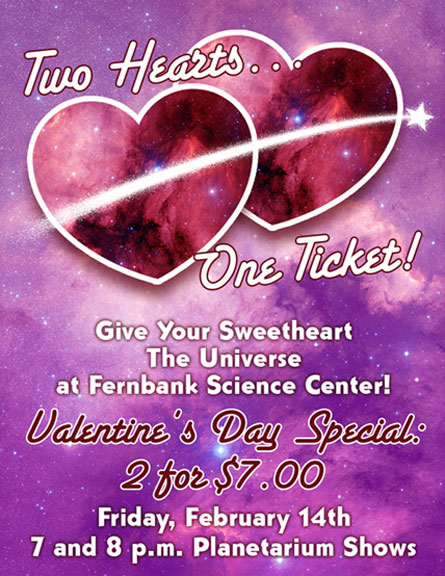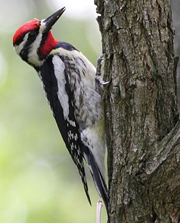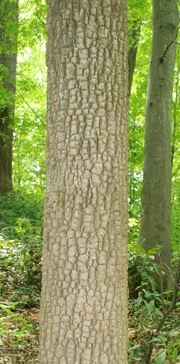Level: Elementary
Water For Birds - an experiment to determine the effectiveness of using moving water to attract birds
Level: Various
Click here for an archive of classroom science activities.
On February 14, The Moon will be directly opposite the Earth from the Sun and will be fully illuminated as seen from Earth (i.e. a full moon). This phase occurs at 11:53 p.m. local time. This full moon was known by early Native American tribes as the Full Snow Moon because the heaviest snows usually fell during this time of the year. Since hunting is difficult, this moon has also been known by some tribes as the Full Hunger Moon.
Source: www.seasky.org
Previous Issues


A neotropical migrant bird is a bird that spends the summer in its breeding range in North America, but migrates to Central or South America for its non-breeding range in winter. The Scarlet Tanager (Piranga olivace) is a neotropical migrant and a regular visitor to the Atlanta metro area during spring and fall migration. The Scarlet Tanager is quite recognizable to most bird watchers, but it can be tricky to identify, especially during fall migration. The problem lies with understanding a couple of things about bird plumage. First, male and female birds do not always have the same plumage. Second, there are seasonal differences in the plumage of some birds as they molt their feathers. The replacement of all or part of the feathers is called a molt. Molts produce feathers that match the age and sex of the bird, and sometimes the season.

Look at the pictures above…notice any differences? In the breeding season (summer) the male (left) is gaudy scarlet red with distinctive black wings and black tail. The female (middle) has a less dramatic olive-yellow coloration. The male also has a drab olive coloration during the winter months (right) as the birds migrate to South America. In science we refer to this difference in appearances as sexual dimorphism and seasonal dimorphism. Dimorphism (di= two, morph = “appearance”) translates as “two appearances.” Therefore, sexual dimorphism means a different appearance for each sex (just like humans) and seasonal dimorphism mean a different appearance for each season (breeding vs. non-breeding).
Click here for the "Did You Know" archive
The Natural Communities of Georgia: Planted in Earth History - Twenty stunning images from The Natural Communities of Georgia by photographers Carol and Hugh Nourse, long time botanical enthusiasts, will be exhibited at Fernbank Science Center from March through April. The photographic exhibit reveals Georgia’s wildflowers, rare plants, and diverse natural habitats. Exhibit commentary is by Dr. Leslie Edwards, Georgia State University biogeographer and first author of The Natural Communities of Georgia and Dr. Bill Witherspoon, Fernbank Science Center geologist and co-author with Dr. Pamela Gore of Roadside Geology of Georgia.
On Thursday March 27 at 7:30 PM, the three authors will discuss Georgia's natural communities and geology at Fernbank Science Center.
This week the terrible news came out that many of us have been dreading. The number of Monarch Butterflies (Danaus plexippus) that made it safely to sanctuaries in Mexico for the winter was the lowest number on record. Please click here for an excellent discussion for the numerous reasons for the precipitous decline of one of our favorite butterflies. But all hope is not lost. There are many things that you can do to help, both at school and at home. Plant a garden with nectar plants, host plants and especially milkweed. Milkweed is the only thing that Monarch caterpillars can eat. If you come to Fernbank's plant sale on March 29th, we will help you find the best plants for your existing or new garden. If you have any questions, please email me a t.neal@fernbank.edu.


AT THE
Toothpick Bridge Building Event
Fernbank Science Center
Saturday, February 22, 2014
1:00 PM to 3:00 PM
Sponsored by the American Society of Civil Engineers Georgia Section, Society of Manufacturing Engineers Atlanta Chapter 61, Fernbank Science Center and the Structural Engineers Association of Georgia. For more information please visit: http://chapters.sme.org/061/bridge.htm

Science Article of the Month
Robots with insect-like brains: Robot can learn to navigate through its environment guided by external stimuli - Scientists have developed a robot that perceives environmental stimuli and learns to react to them. The scientists used the relatively simple nervous system of the honeybee as a model for its working principles. To this end, they installed a camera on a small robotic vehicle and connected it to a computer. The computer program replicated in a simplified way the sensorimotor network of the insect brain.
Read more >> | More articles>>
Do you have a question or a suggestion?
Please email us at:
fernbankmail@fc.dekalb.k12.ga.us

Teacher Resources
![]()
Children's Science
Newsletters
Bird of the Month

Can you I.D. this Bird?
Get the answer in the next issue.
Previous Issue:Dark-eyed Junco Archive
Tree of the Month

Can you I.D. this tree?
Get the answer in the next issue.
Hint: Often used for baseball bats
Previous Issue: Southern Red Oak
Archive
Molecule of the Month

Do you know this molecule?
Get the answer in the next issue.
Hint: Hot!
Previous Issue: peppermint
Archive

